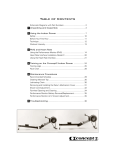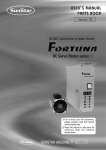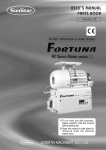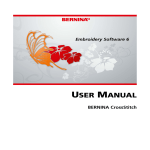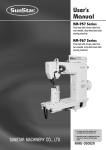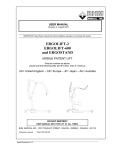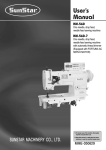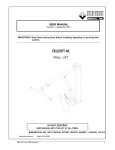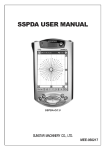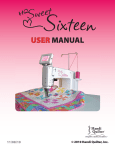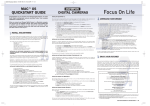Download USER S MANUAL
Transcript
R USER S MANUAL KM-1750/1790 KM-1751/1791 Direct Drive, 2-Needle drop feed (needle feed) sewing machine with automatic trimmer lity a u tQ Besst Pricevice Be st Ser Be 1. Thank you for purchasing our product. Based on the rich expertise and experience accumulated in industrial sewing machine production, SUNSTAR will manufacture industrial sewing machines, which deliver more diverse functions, high performance, powerful operation, enhanced durability, and more sophisticated design to meet a number of user’s needs. 2. Please read this user’s manual thoroughly before using the machine. Make sure to properly use the machine to enjoy its full performance. 3. The specifications of the machine are subject to change, aimed to enhance product performance, without prior notice. 4. This product is designed, manufactured, and sold as an industrial sewing machine. It should not be used for other than industrial purpose. R Contents 1. Machine Type and Specifications .............................................................................. 6 1.1) Machine Type .................................................................................................................... 6 1.2) Specifications ..................................................................................................................... 7 2. Safety Rules ......................................................................................................................... 8 2.1) Safety Stickers ................................................................................................................... 8 2.2) Machine Delivery .............................................................................................................. 9 2.3) Machine Installation ........................................................................................................ 10 2.4) Machine Operation .......................................................................................................... 10 2.5) Repair and Maintenance .................................................................................................. 11 2.6) Type of Safety Labels ...................................................................................................... 11 2.7) Location of Safety Labels ............................................................................................... 12 3. Assembly ............................................................................................................................ 13 3.1) Name of Machine Parts ................................................................................................... 13 3.2) Installation Environment ................................................................................................. 14 3.3) Machine Installation ........................................................................................................ 15 4. Machine Operation ......................................................................................................... 18 4.1) Lubrication ....................................................................................................................... 18 4.2) Test Operation (pedal operation) ..................................................................................... 19 4.3) Needle .............................................................................................................................. 20 4.4) Thread .............................................................................................................................. 20 5. Sewing Methods .............................................................................................................. 25 5.1) How to operate the machine ............................................................................................ 25 5.2) How to Conduct Backtack Sewing ................................................................................. 25 5.3) Adjustment of Thread Tension ........................................................................................ 26 5.4) Adjustment of Presser Foot s Lift and Pressure ............................................................ 28 6. Maintenance ....................................................................................................................... 29 6.1) Adjustment of Feed Dog Height ..................................................................................... 29 6.2) Adjustment of Needle and Hook Timing ....................................................................... 29 6.3) Adjustment of Distance Between Hook Stopper Face and Needle Plate Groove Face .......... 31 6.4) Adjustment of Distance Between Hook and Opener ..................................................... 31 6.5) Suspension of Needle Bars (left, right) (KM-1790 series) ............................................ 31 6.6) Adjustment of Trimming Devices .................................................................................. 34 6.7) Replacement of Moving and Fixed Blades .................................................................... 39 6.8) Adjustment of wiper ........................................................................................................ 40 7. Check and Confirm ......................................................................................................... 41 7.1) Regular Check Points ...................................................................................................... 41 7.2) Cleaning ........................................................................................................................... 41 7.3) Lubrication ....................................................................................................................... 42 7.4) Status Check .................................................................................................................... 43 7.5) Grease Supply (KM-1750SF) ......................................................................................... 44 8. Replacement of Stitch Length Gauge Set ............................................................ 45 8.1) Disassembly Order .......................................................................................................... 45 8.2) Assembly Order ............................................................................................................... 45 9. Cause of troubles and troubleshooting ................................................................ 46 Machine Type and Specifications 1.1) Machine Type Direct drive 2-needle, drop feed sewing machine with automatic trimmer Code Lubrication Type S Semi-Dry Type Dry Micro Lubrication Head M Type 0 1 Auto Lubrication Type Code Application Code Hook Code Trimming F Thin Materials None Standard Hook None None-Trimming G General materials L Large hook 7 Trimming B Heavy materials Direct drive 2-needle, drop feed, feed needle sewing machine with automatic trimmer 6 Code Lubrication Type Code Application Code Hook Code Trimming 0 M Micro Lubrication Dry Type Head G General materials None Standard Hook None None-Trimming 1 Auto Lubrication Type B Heavy materials L Large hook 7 Trimming 1.2) Specifications Direct drive 2-needle, drop feed sewing machine with automatic trimmer KM-1750 Model Item KM-1751 SF MG MBL BL Usage For Thin Materials For General Materials Lubrication Semi-dry Max. Sewing Speed 3,000 spm 4,000 spm 3,000 spm Max. Stitch Length 4 mm 5 mm 7 mm For Heavy Materials Minute Lubrication Adjustment Automatic Lubrication 33.4 mm Needle Bar Stroke Needle Take-up Stroke 52 mm 62.4 mm Feed Dog Height 1 mm Presser Foot Lift 7 mm(manual) / 15 mm(Lap) / 10 mm(automatic) Hook Standard Hook Needle (DP 5) #9~#14(#11) Large Hook #11~#16(#16) #14~#22(#22) Sewing Space 257 mm(W), 120 mm(H), 87 mm (arm jaw) Bed Size 518 mm 178 mm Thread Winder Attached to sewing machine body (upper arm) Automatic Trimmer Standard feed Automatic Backtack Device Standard feed Motor AC servo motor (550W) Power Supply Single-phase (100~240V), 3-phase (200~240V, 50/60Hz) Direct drive 2-needle, drop feed, feed needle sewing machine with automatic trimmer KM-1790 Model Item KM-1791 MG Usage Lubrication MBL For General Materials For Heavy Materials 3,000 spm 5 mm 7 mm Needle Bar Switch Split Needle Bar Needle Bar Stroke 33.4 mm Needle Take-up Stroke Automatic Lubrication Minute Lubrication Adjustment Max. Sewing Speed Max. Stitch Length BL 52 mm 64.6 mm Feed Dog Height 1 mm Presser Foot Lift 7 mm(manual) / 15 mm(Lap) / 10 mm(automatic) Hook Standard Hook Large Hook Needle (DP 5) #11~#16(#16) #14~#22(#22) Sewing Space 257 mm(W), 120 mm(H), 87 mm (arm jaw) Bed Size 518 mm 178 mm Thread Winder Attached to sewing machine body (upper arm) Automatic Backtack Device Standard feed Automatic Trimmer Standard feed Motor AC servo motor (550W) Power Supply Single-phase (100~240V), 3-phase (200~240V, 50/60Hz) 7 Safety Rules 2.1) Safety Stickers The safety stickers in this user’s manual are divided into Caution , Danger , and Warning . They indicate that if the safety rules are not kept, injury or damage to machine might occur as a result. No. Name Description Caution If the machine is not properly handled, it may cause injury to users or physical damage to the machine. Warning If the machine is not properly handled, it may cause death or severe injury to users. Danger If the machine is not properly handled, it may cause death or severe injury to users, and the urgency of the danger is very high. Caution Warning Danger 8 2.2) Machine Delivery Mark Description The machine delivery shall be conducted by the persons who are knowledgeable about the safety instructions and rules. The following safety rules must be observed: 2.2.1) Manual delivery When the machine is manually moved by workers, they are required to put on safety shoes and firmly hold the machine on the left and right side of the table. Danger 2.2.2) Forklift delivery 1) A forklift shall be big enough to endure the weight of the sewing machine and carry the machine. 2) Use the palette when lifting the machine. Set the center of gravity of the machine (center of the left and right sides) at the fork arm of the forklift and carefully lift the machine. Ban people from standing under the machine and remove obstacles near the machine. Warning When the machine is moved by a forklift, a crane, or a transporting device, the balance of the machine must be maintained in order to prevent any deformation of the machine and injury of the workers. 9 2.3) Machine Installation Depending on the installation environment, function errors, breakdown, or other physical damage might result. Make sure to meet the following conditions for machine installation: Caution 1) The workbench or table where the machine is installed should be durable enough to endure the weight of the machine (see the name plate). 2) Dust and humidity are the cause of machine pollution and erosion. Please install an air conditioner and conduct regular maintenance of the machine. 3) Install the machine at the place where it is not exposed to direct sunlight (if the machine is exposed to direct sunlight for a long time, it may cause discoloration or deformation). 4) Secure the space around the machine. Place the machine at least 50cm away from the left, right, and rear walls to secure sufficient space for maintenance activities. 5) Explosion risk : To prevent possible explosion, immediately stop the machine operation if there are inflammable materials in the air. 6) Lights : Lights are not additionally supplied with the machine. If needed, install lights to prevent any inconvenience during work. 7) Overturn risk : Do not install the machine on the unstable stand or table. If the machine drops, it may cause injury or severe impact on the machine. If the machine is suddenly stopped or the external impact is imposed, the machine might be capsized. 2.4) Machine Operation The machine body is attached with Caution and Warning stickers at each dangerous part to emphasize safety instructions. With the full understanding of the safety instructions, make sure to observe the following during machine operation: Warning 10 1) Before turning on the power, read this manual thoroughly and have a full understanding of machine operation. 2) Get properly dressed. Long hair, necklace, bracelet, or wide sleeve might be fed into the machine during operation. Wear slip-free shoes to prevent slipping on the floor. 3) Check the moving scope of machine before its operation to find out whether the scope is proper. 4) Keep hands and head away from the machine parts where accidents might occur (needle, hook, thread take-up lever, pulley, etc.) during operation. 5) Do not remove the safety cover which protects pulley and shaft during machine operation for user s safety. 6) Cut the power supply before disassembling the electric box such as the control box, and double-check that the power switch is Off. 7) Make sure that the power switch is Off when the upper shaft is manually rotated. 8) Stop the machine when the needle is replaced or when inspecting the machine after sewing work is done. 9) Make sure to follow the cautions below. Otherwise, physical damage to the machine such as malfunction and breakdown might result: Do not put articles on the S/M table. Avoid using a crooked needle or the needle with damaged tip. 2.5) Repair and Maintenance When repair is needed, SunStar A/S engineers who have completed certain training course must carry out the repair. 1) Make sure to turn off the main power supply and wait for four minutes for the machine to be fully discharged before conducting cleaning or maintenance of the machine. Servo motor and control box need 10 minutes before they are fully discharged after power supply cut. Danger Caution 2) Do not modify the machine specifications or machine parts without substantial consultation with SunStar. Otherwise, the modifications may threaten the safety of the machine during its operation and cause safety accidents. 3) Make sure to use SunStar's original parts for repair and parts replacement. 4) When the repair is completed, put back all the disassembled safety covers. 2.6) Type of Safety Labels Do not operate without finger guard and safety devices. Before threading, changing bobbin and needle, and cleaning, turn off the main switch. Hazardous voltage will cause injury. Be sure to wait at least 360 seconds before opening this cover after turn off main switch and unplug a power cord. 11 2.7) Location of Safety Labels 12 Assembly 3.1) Name of Machine Parts 3.1.1) Name of Machine Parts Thread winder Reverse button Lap lift lever Reverse lever O/P panel Safety devices Thread take-up cover Wiper Device Presser foot Power switch Stitch length dial Thread Stand Presser bar lifting lever Control box Oil window S/M pulley Finger guard Motor cover 13 3.2) Installation Environment 3.2.1) Installation Environment 1) To prevent accidents stemming from mal-operation, do not use the machine if the voltage is 10% above the rated voltage. To guarantee smooth operation of the product, the installation environment shall be prepared as described in User’s Manual. Otherwise, unexpected damage might occur to the product. Caution 2) Proper temperature during machine operation : 0 ~ 40 C (32 ~ 104 F) 3) Proper temperature during machine storage : 25 ~ 55 C ( 13 ~ 131 F) 4) Humidity : Relative humidity – within 45 ~ 85% 3.2.2) Electricity Environment Warning The voltage of the power supply should move within the range of 10% of the rated voltage. Insert the power plug of the sewing machine directly into the AC outlet. If an extension cord is used, it may cause mal-operation of the sewing machine. 1) Power voltage The power voltage shall be within 10% of the rated voltage. It is recommended to use the power frequency within 1% of the rated frequency (50/60Hz). 2) Noise of electromagnetic wave Do not install the sewing machine next to a TV, a radio, or a cordless phone. The machine may be interfered by a TV, a radio, or a cordless phone. 3) Take care not to spill water and coffee on the machine. 4) Do not drop Control Box and the motor to the floor. 14 Caution 1) To prevent safety accidents, at least two persons should be involved in the installation and transportation of the machine. 2) It is recommended to use the table supplied by SunStar. If the table is internally made, the table should be at least 40mm thick and durable enough to support the weight of the sewing machine. 3.3) Machine Installation 3.3.1) Table Installation 1) Table Fixing Insert the shock-absorbing rubber into the level adjuster and turn it until the caster can move freely. Fasten the nuts after table installation and fix the level adjusters. 2) Adjustment of Table Height Use the bolt attached to the table to adjust its height to the level that enables convenient work for the users. Bolt Nut Level Adjuster Shock-absorbing Rubber Caster 3.3.2) Installation of Control Box 1) Location of Control Box and Petal Install the bracket, the pedal switch, and the connection rod, and then properly adjust the length of the connection rod. 3.3.3) Installation of Oil Pan 1) Attach four cushion rubbers to the corners of the oil pan and install the oil pan to the table. 2) Insert the lap lifting cap into the oil pan. Lap Lifting Cap Cushion Rubber 15 3.3.4) Hinge Rubber 1) Install two hinge rubbers on the table, and use nails to fix them on the table. Hinge Rubber 3.3.5) Assembly of Sewing Machine 1) Insert two hinges firmly into the holes of the rear side of machine bed. 2) Put machine body on the rubber cushion , while putting hinges on the hinge bed rubber safe and sound. 3) Insert the machine body sustaining pole into table completely. If the pole is not inserted completely, that may cause accidents because the pole cannot sustain the weight of machine body firmly, when the body bent backwards. rubber cushion sustaining pole hinges hinge bed rubber Caution 1) At least two persons shall be involved in the assembly of the sewing machine body to the table for safety. 2) When the body is leaned backward, if the support bar shakes, safety accidents may occur. 3.3.6) Operation Panel Assemble the operation panel to the bracket, and attach them on the rear side of the machine body. 16 3.3.7) Thread Stand Assemble the thread stand and install it on the table. Then adjust the location of the thread stand for convenient use. 3.3.8) Lap Lifting Plate 1) Install the lap lifting plate below the oil pan and use the bolts to fix it. 2) Use the location adjusting bolt of the lap lifting plate to move it to the proper location. Lap Lifting Plate 3.3.9) Adjustment of Presser Foot Height 1) Turn the pulley to locate the feed dog below the needle plate. 2) When the presser foot is in the upper position, adjustment is impossible. Pull down the presser bar lifting lever to lower the presser foot. 3) Use the adjusting screw to adjust the height of the presser foot from 10mm, the standard height, to 15mm, the maximum height. Presser bar lifting lever 17 Machine Operation 4.1) Lubrication Warning Caution 1) Until oil supply is completed, do not insert the power plug into the outlet. If the power is supplied and the pedal is accidentally stepped, injury might occur due to unintended machine operation. 2) When handling lubricant, put on safety glasses and gloves. Take extra care to prevent lubricant from touching eyes and skin. When lubricant contaminates hands, wash it out in running water using soap. If lubricant contaminates eyes, immediately wash them out in running water and see a doctor. 3) Do not drink lubricant. It may cause diarrhea and vomiting. If you drink lubricant, immediately see a doctor. 4) Keep lubricant in a safe place away from the reach of children and youth. 1) At the first use of the sewing machine after purchase or when the machine is used after it has not been used for a while, oil supply is required. 2) Use the SunStar’s original lubricant products (lubricant is in the accessory box). 3) When supplying lubricant, check the supplied volume to make sure that lubricant will not overflow. 4.1.1) Lubrication Lean backwards the sewing machine and supply lubricant using the lubricant can until the punched mark of the oil cover. Use the lubricant supply can which is located in the accessory box to supply lubricant into the oil tank. Remove the rubber cap and supply lubricant until it reaches between the up and down punched marks on the oil window. During lubrication, insert the outlet of the oil can into the oil cover to prevent oil spilling on the floor. Caution 18 4.1.2) Others Use the lubricant can to supply two to three drops of lubricant around the oil wick and felt. Note 1) Arm lubrication : Disassemble the face plate, and lubricate the major friction areas of the parts including the thread take-up hinge pin, the needle bar frame, the thread take-up holder, the thread bar crank, and the guide block. 2) Bed lubrication : Lower shaft’s front bushing, lower shaft s middle bushing felt, hook support’s gear felt 4.1.3) Oil supply(KM-1751/1791 Series) 1) Installing chip remover magnet Attach the magnetic chip remover that is in the accessory box to the oil fan. Do not use the magnet for other purposes. Use of the sewing machine without the magnet may cause malfunction and has a bearing on the machine’s durability. Caution 2) Lubricating the oil fan A. Fill the lubricant up to the “HIGH” mark. B. The lubricant must be SUNSTAR’s oil provided exclusively for industrial sewing machines or SHELL’s Tellus C10. C. If the oil in use is down to the “LOW” mark, fill in to “HIGH” immediately. D. Once every two weeks is deemed the appropriate interval for oil refills. magnet 4.2) Test Operation (pedal operation) Do not touch or press with objects the moving or spinning parts of the sewing machine, while it is in operation. It may cause injury or damage to the machine. Caution 19 1) Lightly press the pedal in the B position to make sure that the low speed sewing is properly conducted. 2) Press the pedal until the C position to check whether the high-speed sewing is properly conducted. 3) Press the pedal forward (B or C position) and release the pedal to locate it at the neutral (A) position. And check whether the needle stops below the needle plate s front side (in case where the lower-position needle stop is set). 4) Press the pedal at the D position (Press the pedal to D and move it to the neutral (A) position). Then after trimming, the needle stops above the front side of the needle plate. 4.3) Needle 1) Turn off the power stitch when installing the needle. 2) If the pedal is accidentally stepped, it may cause injury or accident. Caution 4.3.1) Needle Installation 1) Turn the pulley to place the needle bar at the highest position. 2) Place the needle’s groove headed inward and thoroughly push the needle until its end touches the stopper, and then fasten the needle with the fixing screw. KM-1750 Series 4.4) Thread Turn off the power switch to separate the bobbin case. If the pedal is accidentally stepped, it may cause injury. Caution 4.4.1) Separation of Bobbin and Bobbin Case 1) In case of a regular hook (Latch type) Turn the pulley to place the needle at the highest position. Open the sliding plate and remove the bobbin by erecting the bobbin holder. 20 KM-1790 Series 2) In case of a large hook (bobbin case type) Turn the pulley to place the needle at the highest position. Open the sliding plate and remove the bobbin and the bobbin case by erecting the bobbin holder. 4.4.2) Lower Thread Winding Take caution for the spinning or moving parts when winding the bobbin. Injury or damage to the machine might be caused. Caution 1) Insert the bobbin into the thread winding shaft on the winding base, which is attached to the upper arm. 2) Wind the thread around the bobbin several times, and lift the presser bar by using the presser bar lifting function. 3) Attach the thread winding lever to the bobbin and press the pedal to wind the thread around the empty bobbin. 4) After the thread winding lever is separated from the bobbin, use the thread winding blade to cut the bobbin thread. 4.4.3) Adjustment of Thread Winding Volume Loosen the screw on the thread winding plate to adjust the location of the thread winding plate and the wound thread volume. The wound thread volume should be up to 80%. Caution 21 4.4.4) Bobbin Installation Caution 1) To separate the bobbin case, turn off the power switch. 1) If the pedal is accidentally stepped, injury might result due to unwanted machine operation. 2) Upon the bobbin installation, insert the anti-spinning spring into the bobbin case. 1) Standard hook (Latch type) Upon trimming, insert the anti-spinning spring into the bobbin case. Install the bobbin on the hook in the thread winding direction. Move the thread to the A part of the hook and make the loose thread 50mm. Close the left and right sliding plates. 2) Large hook (bobbin case method) Upon trimming, insert the anti-spinning spring into the bobbin case. Install the bobbin on the hook in the thread winding direction. Move the thread to the A part of the hook, and make the loose thread 50mm. Close the left and right sliding plates. 3) Feeding each needle (bobbin case method) (KM1790) Upon trimming, insert the anti-spinning spring into the bobbin case. Install the bobbin on the hook in the thread winding direction. Pass the thread in the order of A, B, and C, and make the loose thread 50mm. Close the left and right sliding plates. 22 Anti-spinning Spring 4.4.5) Routing the lower thread [ Applicable Models ] a) KM-1750 MG b) KM-1750 MBL A. Insert the bobbin into the hook . B. Insert the thread through A part of the hook , and pull it out from the end of the lower thread tension adjustment plate . C. The adequate length of the pulled-out lower thread is 50mm. ( Application Standard ) KM-1750 MBL [ Applicable Models ] a) KM-1790 MG b) KM-1790 MBL A. Insert the bobbin into the bobbin case . For KM-1790 MG, it is crucial to insert the bobbin in the turning direction as in the picture. B. Insert the thread through A part of the bobbin case, and pull it out from the end of the lower thread tension adjustment plate . C. Pass the pulled-out thread through B and C of the bobbin case, as can be seen on the picture, and hang it onto the lower thread holding spring . Then pull it out through the thread hole . D. The adequate length of the pulled-out lower thread is 50mm. (Application Standard) KM-1790 MBL 23 4.4.6) Upper Thread Placement When separating the bobbin case, turn off the power switch. If the pedal is accidentally stepped, and the machine begins operating, injury might occur. Caution Turn the pulley to locate the thread take-up lever at the highest position, and place the upper thread. Place the left-hand thread first. 4.4.7) Using Lap Lifting Pad The presser foot can be lifted or lowered using the lap lifting pad. 24 Sewing Methods Caution 1) Make sure to keep all safety devices on their place to prevent any injuries. 2) Please turn off the power switch in the following situations where accidental stepping of the pedal might cause injuries. Replacement of bobbin and needle and upper thread placement When the machine is left unused for a long or temporary leaving while the machine is in operation 5.1) How to operate the machine 1) Pull the two strands of upper threads with a hand and turn the pulley until the lower thread moves above the feed dog. 2) Pull the upper thread toward the direction of the user and check whether the lower thread is smoothly released. 3) Press the power button ( On button) to make the panel lamp on and the sewing machine ready for operation. 4) Set the operational panel based on the user s manual of Fortuna IV. 5) The machine is ready to work. It will start sewing when the pedal is pressed. Power Switch 5.2) How to Conduct Backtack Sewing 1) During sewing, if the reverse switch or the reverse lever is pressed, the sewing materials will move backwards. Otherwise, they will move forward. 25 5.3) Adjustment of Thread Tension Caution Before adjusting the thread tension, make sure to turn off the power switch. If the pedal is mistakenly stepped, it may accidentally operate the sewing machine, causing injuries. Sewing conditions may differ depending on sewing fabric, thread, stitch count, and other conditions. Make adjustments in line with the table below: Sewing Type Cause Actions Balanced good stitch When the upper thread tension is too weak or the lower thread tension is too strong Strengthen the upper thread tension or weaken the lower thread tension When the upper thread tension is too strong or the lower thread tension is too weak Weaken the upper thread tension or strengthen the lower thread tension 5.3.1) Adjustment of Upper Thread Tension When the tension adjusting nut for the thread tension adjuster is turned clockwise, the upper thread tension will get stronger. When it is turned counterclockwise, the upper thread tension will get weaker. 5.3.2) Adjustment of Lower Thread Tension When the tension adjusting nut for the hook is turned clockwise, the lower thread tension will grow stronger. When it is turned counter-clockwise, the lower thread tension will grow weaker. Weaker Stronger [ Latch Type ] 26 [ Bobbin Case Type ] 5.3.3) Adjustment of Thread Take-up Lever Spring 1) Adjustment of Thread Take-up Spring Motion Loosen the tightening screw for the stopper, and adjust the spring stopper to adjust the spring motion (The thread take-up spring lever moves in the range from 5 to10mm). 2) Adjustment of Thread Take-up Spring Tension Loosen the screw on the thread adjusting shaft. When the groove on the thread adjusting shaft is turned clockwise using a driver, the thread take-up spring tension grows stronger. When it is turned counter-clockwise, the tension grows weaker (The standard tension is 30~70g). 5.3.4) Adjustment of Thread Release Motion (automatic trimming) If the upper thread escapes from the needle hole after trimming, adjust the opening of the dish as below. Activate the thread release solenoid and adjust the solenoid shaft collar back and forth to set the opening of the thread tension adjusting dish at 0.8mm. If the thread release solenoid is not in operation, check whether the dishes are closely contacted. If the dishes are not properly separated despite their proper assembly, check the front face of the control box to see if the remaining upper thread adjustment volume is set at the low level. Caution 5.3.5) Adjustment of Auxiliary Thread Adjuster (automatic trimming) Adjust the auxiliary thread tension adjusting nut to set the remaining upper thread to be 35~45mm. The adjustment can be made using the remaining upper thread length adjustment volume on the control box. Note 27 5.4) Adjustment of Presser Foot’s Lift and Pressure Sewing Type Cause Corrective Actions Balanced good stitch When stitch skip takes place or when the stitch length is irregular Strengthen the pressure When puckering takes place Weaken the pressure 5.4.1) Adjustment of Presser Foot Lift Loosen the pressure adjusting screw and the tightening screw for the presser bar bracket. With the presser bar lifting lever pulled up, set the distance from the needle plate face to the bottom of the presser foot at 7mm, and fasten the bracket tightening screw. 5.4.2) Adjustment of Presser Foot Pressure Use the pressure adjusting screw to adjust the presser foot pressure. When the adjustment is completed, fasten the fixing nut. 28 Presser Bar Lifting Lever Pressure Adjusting Screw Maintenance 1) 2) 3) 4) Caution Skilled engineers should carry out repair and maintenance of the sewing machine. When electric repair and maintenance is needed, request the distributor shops or electricity experts. If the safety devices are separated, make sure to put them back into their original places. Use both hands to lead backward the sewing machines or place it back to the original place. If only one hand is used, due to the weight of the machine, the hand might be stuck or other injury might occur. 5) In the following cases, turn off the power switch and pull off the power plug. If the pedal is accidentally stepped, unwanted operation of the sewing machine might occur, causing injuries. Regular check, maintenance, repair Replacement of supplies such as needle, hook, and blade Adjustment of lubrication to the hook 6) If adjustment is made when the power switch is on, take extra care to secure safety. 6.1) Adjustment of Feed Dog Height Turn the pulley to place the feed dog at the highest position. Then loosen the tightening screw for the feed dog support to move it up and down. Adjust the feed dog to protrude some 1mm from the needle plate face in parallel. Feed Dog 1mm 6.2) Adjustment of Needle and Hook Timing 6.2.1) Adjustment of Up/Down Needle Bar Position 1750 Series 2.4mm 2.4mm Turn the pulley to place the needle bar at the lowest position. Loosen the tightening screw for the needle bar holder to place the punched mark of the needle bar at the end of the frame. When adjustment is completed, fasten the tightening screw for the needle bar holder again. 1790 Series 29 6.2.2) Adjustment of Crossing Timing of Hook’s Upper End and Needle Center 2.4mm 1.5mm 1) Set the stitch length at 2.5mm for KM-1750, 1750-7, 1790, and 1790-7 models. Set the stitch length at 3.5mm for KM-1750BL, 1750BL-7, 1790BL, and 1790BL-7 models. Loosen the tightening screw for the hook gear to make the upper end of the hook accurately meet with the needle center when the needle bar is placed 2.4mm above from the highest needle bar position. When adjustment is completed, fasten the screw again. After the adjustment, the upper hook will be located 1~1.5mm above the upper thread hole of the needle. 2) For 1790 series, if the height of the left and right needles is not same, as displayed in the figure, lift the needle bar 2.4mm from its lowest position. If the upper end of the hook is not 1~1.5mm above the upper end of the needle thread hole in this case, loosen the fixing screw to remove the needle holder and then adjust the fixing screw for the needle holder up and down to adjust the height of the needle. 3) Adjustment of Distance Between Needle and Hook s Upper End Lift the needle from the lowest position and make the hook s upper end meet with the needle center. When the lower end of the needle touches the needle guide plate of the hook (adjustment of the needle guide s configuration), loosen the screw and move the hook support left and right to adjust the distance between the hook s upper end and the needle groove to be 0.05~0.1mm. When adjustment completes, tightly fasten the screw again. 30 6.3) Adjustment of Distance Between Hook Stopper Face and Needle Plate Groove Face The standard distance between the hook stopper face and the needle plate groove face is 1.3mm. This distance can be adjusted using the thickness of the space washer which is located below the hook. Loosen the fixing screw for the hook gear to separate the hook and insert the space washer which is initially assembled status after repair or replacement. Space Washer Fixing Screw for Hook Gear Depending on machine model, the washer in use may have different thickness. As such, make sure to use the initially assembled space washer. Caution Loosen the tightening screw for the opener to set the distance between the hook and the opener at 0.2mm when the opener is pushed at the maximum in the arrow direction, and adjust the left and right sides of the opener. 0.2mm 6.4) Adjustment of Distance Between Hook and Opener Opener Tightening Screw Hook 6.5) Suspension of Needle Bars (left, right) (KM-1790 series) 6.5.1) Button Use 1) Suspension of Left/Right Needle Bars (when conducting corner sewing at left/right sides) Press the needle bar switch of the desired spinning direction and then the concerned button lamp blinks. 2) Switch to 2-Needle Sewing Press the switch button which is blinking again to cancel the setting. Suspend Suspend 31 6.5.2) Program Application (for semi-automatic corner sewing) The model equipped with E-Type controller can carry out program-guided corner sewing. Note For semi-automatic corner sewing, necessary data and code numbers should be entered into the program box in advance. To switch from general sewing to corner sewing, press a desired left needle or right needle button and press the pedal once. Then the concerned needle will stop at the highest position and the opposite needle will stop after sewing the predefined number of stitches. Set the sewing fabric at the different angle and step the pedal again. Then the needle bar stops after sewing the pre-defined number of stitches. At the third pressing of the pedal, the suspended needle at the highest position will be automatically released, and the regular two-line sewing will be conducted. 6.5.3) Programming Order Have a thorough understanding of program entry methods from the electric/electronic manual, and conduct programming using the default values of A group codes from #30 to #36. Note 1) Call Code# 30 and enter 1 as the default value. When 1 is entered, the semi-automatic corner sewing can be conducted. When 0 is entered, the function cannot be conducted. 2) Call Code# 31 and set the sewing speed for corner sewing. The speed can be freely adjustable at the range of 24spm to 2040spm. 3) Corner sewing Direction Setting Left corner sewing When the left needle stops at the highest position, enter 32 as the first sewing stitch count for the right needle, and enter 33 as the second sewing stitch count. Right corner sewing When the right needle stops at the highest position, enter 34 as the first sewing stitch count for the left needle, and enter 35 as the second sewing stitch count for the left needle. Note The number of stitches for left and right needles ranges from 0 to 64. Conduct the programming as set forth above and operate the machine following the semiautomatic corner sewing method as explained above. Then the semi-automatic corner sewing will be repeated using the pre-entered data. 4) Code# 36 To protect the left and right solenoids, the automatic power-off time after their operation is completed can be set. The default value is 450(45 seconds) and it can be set at the range of 5(0.5 seconds) to 1275 (127.5 seconds). 32 5) Exercise Please enter the data below and conduct corner sewing. Then the sewing results as below will be produced. Initial configuration What it means 30 1 Whether or not semi-automatic corner work will be carried out 31 1500 Code No. 32 2 33 1 34 5 35 5 36 450 Right needle upstop position First round number of stitches (5 stitches) Speed of semi-automatic corner work First round no. of stitches for the right needle when the left needle is in up-stop position Second round no. of stitches for the right needle when the left needle is in up-stop position First round no. of stitches for the left needle when the right needle is in up-stop position Second round no. of stitches for the left needle when the right needle is in up-stop position Left needle up-stop position order Rig h stop t need pos le up Sec ition num ond rou (5 s ber of nd titch stitc hes es) Left needle up-stop position First round number of stitches (2 stitches) Left needle up-stop position Second round number of stitches (1 stitch) Right needle up-stop position order Left and right needle solenoid waiting time Details: Corner sewing speed is 1500 spm, and the retention time of left/right solenoids is 45 seconds. When the semi-automatic corner sewing data has been entered and the left/right button is pressed before sewing, the semi-automatic corner sewing will be conducted when the pedal is pressed. Caution 6.5.4) Table for Stitch Count Adjustment (ex: stitch length 1/4 ) See the beside table for accurate corner sewing and set the stitch length accordingly. When the sewing angle and the stitch length are known, it is possible to find out by how many stitches the outer needle should be moved forward. No. of stitches sewing angle No. of stitches: 6 Working angle 40 [ left turn sewing ] When the sewing angle is 40 and the stitch length is 2.9mm, the outer needle should move straight forward by six stitches. 33 6.6) Adjustment of Trimming Devices 6.6.1) Adjustment of Trimmer Driving Part 1) Trimmer Cam Location Turn the pulley by hand to locate the needle bar at the lowest position. Put the trimmer cam and the lower-shaft middle bushing closely together and turn the cam to make punched marks meet each other. Then fasten the tightening screw. Needle Bar Fixing Screw Lowest Point Lower-Shaft Punched Punched Trimmer Mark Middle Bushing Mark Cam When the trimmer cam position is adjusted, turn the pulley by hand to check whether it rotates smoothly. Caution 2) Adjustment of Stopper Pin Holder Turn the pulley to place the trimmer cam within the scope of the complementary straight line. Insert the trimmer oscillator link fully into the roller and adjust the holder to ensure the close contact between the trimmer oscillator link and the right side of the roller. Adjust the holder to ensure the close contact between the stopper pin and the left side of the stopper pin holder. Stopper Pin Holder Close Contact Roller Stopper Pin Fixing Screw Trimmer Oscillator Link Complementary Straight Line Point of Trimming Completion Roller Close Contact Trimmer Cam ( The current stop position of the cam indicates that the cam guide is within the complementary straight line before the roller is removed after trimming.) Point of Moving Blade Motion Start [ Trimmer Cam Guide ] When the stopper pin holder adjustment completes, if the trimmer oscillator does not move smoothly, minute adjustment of the holder is required. Caution 34 3) Fixing the position of the trimmer solenoid (ass y) (See figure) When the whole trimmer shake linkage is in up position, that is, when it has come back to its original position after finishing trimming, the distance between the lower part of the roller and the equal point of the trimming cam is about 0.8~1mm. Assuming that this distance never changes, adjust the position of solenoid bracket horizontally, where the solenoid housing is attached, to make the solenoid stroke 4 mm. Then, tightly fasten with fixing screw . After adjusting the solenoid stroke , manually operate the solenoid shaft towards the arrow direction. See whether it returns to its original position fast and smooth when released. If not, proceed with horizontal adjustment of the bracket . 4mm Solenoid Stroke 0.8mm~1mm 6.6.2) Adjustment of linking device for movable knife shaft and the trimmer driving part (See figure) 1) When the previously explained adjustment of trimmer driving part is complete, it is in its normal position where the trimmer shake linkage has returned to its up position after trimming action. 2) First, loosen the fixing screw of the movable knife shaft (right), hold the initial assembling angle of the crank (right) to be about 15 , 30 to the left from the perpendicular line drawn to its center . To make sure that this position is maintained, adjust the length of the ball joint linking bar which comes assembled to trimmer shake linkage . Also, adjust the fixing screw tightly. (For the adjustment of the ball joint linking bar , turn the linking bar after loosening the nuts (left) and (right) . is left nut and is the right nut.) 3) Then, loosen fixing screw of the movable knife shaft crank (left) , and in the same angle as the crank(right) s lower assembling angle , place the crank(left) . Tightly fasten the fixing bolt to make sure this position holds. 4) When the linking device is connected as such, the movement angles , , , of crank (left) and (right) during trimming movement results in an equal angle movements for left and right, against the perpendicular lines and that are drawn from the center line of the two movable knife shafts. Hence, it can be said that the trimming movement is very light. 35 6.6.3) Adjusting movable and fixed knives 1) Adjusting the position of movable knife-edge and hook stopper (See figure) When a movable knife passes the front side of the hook stopper , adjust the distance to be within 0.05~0.2 mm range like part . The upper surface of the movable knife-edge should be set up 0.2mm below the upper side of hook stopper . (Given that the fixed knife is pressing down the movable knife) Clearance adjustment of the movable knife edge and hook stopper front side Loosen the needle plate Place the hook stopper in the hanging position to the needle plate Holding the hook with the hand, manually operate trimming movement so that the movable knife-edge is matches the stopper front side . Loosen the fixing screw of the movable knife shaft eccentric bushing. In the lower side hole of the eccentric bushing , stick in a thin driver or adequate pin and turn right and left. This will make the position of the movable knife shaft change, hence changing the distance . When the clearance adjustment is finished, tightly fasten the fixing screw of the bushing. The adjustment of crossing height between the hook stopper upper side and movable knife edge upper side is possible to certain degree by adjusting the movable knife base washer or by changing the position of movable knife shaft collar , as can be seen in figure. 0.2mm 0.05mm~0.2mm 36 2) Adjusting movable and fixed knife (See figure) Like in figure, adjust the position of the fixed knife so that the fixed knife right side edge matches the movable knife inner side edge . The initial assembling position of the movable knife is where the movable knife-edge protrudes about 3 mm from the edge of the fixed blade. Please check the final fixing of the movable knife initial position on page 38. The surface adhesion conditions of fixed blade edge and movable knife upper side have huge impact on its trimming capacity. Please note the various cases of movable/fixed knife surface adhesion conditions on the picture. [Correcting the adhesive conditions of movable and fixed knives] Like in figure, operate manual trimming movement with magic ink on the movable knife-edge. By checking the ink trace remaining on the movable knife, the surface adhesion condition of the movable/fixed knives can be tested. If the surface adhesion is not very good (same method is used to adjust the tension of movable/fixed knives), please use the following methods: adjusting the amount and position of the washer in the lower side of the movable knife base , horizontally adjusting the assembling position of movable knife shaft collar , and correcting the shape of fixed blade setting position. 3mm [ Checking the surface adhesion ] Apply magic ink on the upper side of the movable knife-edge (good) (bad) (bad) 37 3) Final fixing of the movable knife’s initial position (See figure) Caution The standard initial assembling position of the movable knife is where the movable knifeedge protrudes about 3mm from the fixed blade edge when the trimming action is finished, that is, when the movable knife is in its initial stop position. When fixing the position of the movable knife, the following directions must be followed so that the power generated in the cam is delivered without any loss to the trimming action. trimming finish point complementary straight line 3mm [Movable knife initial assembling position] 4) Adjusting lower thread holder (See figure) The position of lower thread holder is set by fixed blade and bolt . Like in the picture, loosen the bolt and place the lower thread holder edge at the lower side of the movable knife , about 8mm apart from the movable knife edge . Make sure to of the check that the right and left upper sides lower thread holder is tightly adhered to the lower side of the movable knife. 38 3mm 8mm starting point of movable knife movement [Trimming cam lead] [ Adjustment Order ] Manually turn the pulley to finish trimming of the trimming cam . Place the cam so that the roller can enter the complementary straight line . Slightly loosen the fixing screws of movable knife shaft crank of both the left and the right. Press the trimmer shake linkage to enter the roller inside the cam. Push the linking bar to the right or the left crank linking rod to the left so that there is no excess room in each linking device. When this is done, the roller gets to adhere to the right side of the cam s complementary straight line , as can be seen in the picture . While maintaining this position, adjust to make the movable knives on the right and the left protrude about on both sides. 3mm from the fixed blade-edge . Now, tightly fasten the crank fixing screws If the initial position of the movable knives of both sides are to be adjusted slightly, use the ball joint linking bar . If only the movable knives are to be adjusted, use the linking rod . 5) Checkpoints on the assembling status of other trimming devices Check the starting point of the movable knife when the trimming action takes place Operate trimming movement manually to check whether the thread take up lever is in the lowest or at least 2.5 mm raised level when the movable knife starts working, like in figure. 0~2.5mm Point where the movable knife starts Thread take its movement up lever’s lowest point Maintenance of fixed blade When the thread does not get trimmed or if the trimmed section of the thread is sloppy, please check the edge condition of the fixed blade. If the edge of the knife is too dull, sharpen the edge using oil stone or sand paper. (See figure) 60 OIL STONE 60 SAND PAPER 6.7) Replacement of Moving and Fixed Blades 6.7.1) Replacement of Moving and Fixed Blades 1) Lift the presser foot, open the sliding plate, and disassemble the needle plate. 2) Disassemble the washer, the fixed blade, and the lower thread holder, and then disassemble the moving blade. Presser Foot Moving Blade Needle Plate Moving Blade Fixed Blade Lower Thread Holder 39 6.8) Adjustment of wiper about 0.3 mm about 0.3 mm about 0.3 mm 1) Set the needle (at the needle position on the control after trimming) 2) Set the stitch length at dial 2 . 3) When pressing with hand as in the picture, the wiper edge should protrude about 0.3 mm from the needle edge. Loosen the four clamp screws to vertically adjust the solenoid . 4) Hang the thread onto the two needles. 5) The position of the wiper edge should look like the picture , where the two hooks of the wiper can securely hang the thread. To do so, loosen the clamp screws of the wiper and horizontally adjust the wiper . about 0.3 mm 6) When the wiper is in waiting position, the distance between the wiper edge and the presser bar equal point should be about 3 mm. To do so, loosen the clamp screw and vertically adjust the stopper . Depending on the thread type, there are cases where the thread cannot be hung to the wiper edge. Hence, it is necessary to bring the wiper into the range of the needle where the thread from the sewing material can be hung. Make sure that the needle fixing screw does not get in the way of the wiper. 0.5~1mm 7) The trace of wiper edge is as the above picture. Adjust the wiper edge by loosening the clamp screw vertically adjusting the distance between the needle edge and wiper to 0.5~1mm. 40 and Check and Confirm Caution Warning 1) Observe the mechanic and electric safety rules during the check and maintenance of the machine. 2) Conduct lubrication while the machine power is off. 1) Do not insert the power plug into the outlet until the lubrication completes. While the power is supplied, if the pedal is accidentally stepped, and unwanted machine operation results, it may cause injuries. 2) When handling lubricant, put on safety glasses and gloves to protect skin and eyes. When lubricant contaminates hands, wash it off in running water using soap. If lubricant is inserted into the eyes, wash it off immediately in running water and see a doctor. 3) Do not drink lubricant. It may cause diarrhea and vomiting. If lubricant is mistakenly drunk, immediately see a doctor. 4) Keep lubricant in a safe place out of the reach of children and youth. 5) Use two hands when leaning the sewing machine backward or placing it back to the original position. If only one hand is used, it may slip away from the machine due to the weight, and it may be stuck inside the machine. 7.1) Regular Check Points 1) Cleaning, lubrication, and grease supply for particular areas should take place on a regular basis to keep the machine at the best conditions. 2) Check the tension of each driving belt. 3) When the regular checks are not properly performed, the following problems might result. Abnormal abrasion of the oiled parts due to the lacking supply of lubricant and grease Abnormal operation due to the dust and foreign materials stuck around the driving parts 4) If the machine was left unused for a long time, resume its operation after cleaning and maintenance activities. 7.2) Cleaning 7.2.1) Cleaning Frequency and Method 1) Make sure to turn off the power of the machine before cleaning. 2) The parts disassembled for cleaning should be assembled in the reverse order of disassembly. Caution NO. Required Parts for Cleaning 1 Around Hook 2 Thread take-up lever / thread tension adjusting device 3 Around the moving and fixed blades Remove the dust from the moving and fixed blades located below the needle plate using air. 4 Treatment of Waste Oil Cleaning Frequency Daily Once a week Three times a week Once a month 41 7.2.2) Cleaning 1) Place the needle at the highest position. 2) Disassemble the bobbin after opening the left and right slide plates. 3) Use the soft brush, etc. to remove dust from the hook and the feed dog. 4) Remove the bobbin after the cleaning completes. 7.3) Lubrication 7.3.1) Lubricant Use the original SunStar s lubricant in the accessory box. 7.3.2) Oil Tank Fill-up Remove the rubber cap and supply oil until the full mark on the oil window. 7.3.3) Oil Cover Fill-up Lean backwards the sewing machine and check the oil in the oil cover. Supply oil until the full mark. 42 7.4) Status Check 1) Replace the needle if it is deformed or the tip is damaged. 2) Check whether the upper thread is properly placed. 3) Conduct the test sewing. Caution 1) Upon lubrication, make sure that lubricant does not overflow. Check the supply volume during lubrication. 2) Lubricant shall not move above the Full mark on the oil window. Otherwise, lubricant leakage may take place. 7.4.1) Adjustment of Lubrication to Hook 1) Oil Amount Check Turn off the power and remove the thread from the needle and the thread take-up lever. Remove the needle and the bobbin and lift the presser foot. Turn on the power and run the sewing machine for one minute at regular speed. Place the oil status checking paper on the hook and check the oil volume sprayed to the paper by running the machine at regular speed for some 8 seconds. Min. Sprayed Max. Sprayed Oil 0.5mm Oil 1mm 2) Adjustment of Lubrication to Hook Lean backwards the sewing machine and adjust the lubrication to the hook using the oil supply adjusting screw. Turn the oil supply adjusting screw clockwise, and the oil supply will be reduced. Turn the oil supply adjusting screw counter-clockwise, and the oil supply will increase. Use the sewing machine for 2 hours, and check the oil supply to the hook. 43 7.4.2) Face plate oil level check(KM-1751/1791 Series) If there is excessive or insufficient amount of oil provided to the face plate from the thread take up lever hinge pin, loosen the face plate oil level adjustment screw fixing nut and adjust the face plate oil level adjustment screw. After adjustment, tighten the fixing nut. 7.5) Grease Supply (KM-1750SF) 7.5.1) Grease Preparation Use the original SunStar’s grease product to supply grease every six months by using the enclosed supplying device. 7.5.2) How to Supply 1) 2) 3) 4) 5) 44 Turn off the power. Loosen the screws. Supply grease through the part marked with an arrow. Reassemble the screws. Turn on the power. fixing nut oil level adjustment screw Replacement of Stitch Length Gauge Set Carry out the replacement while the power is off. Caution 8.1) Disassembly Order 3. Disassemble the left and right needle holders (KM-1790 series) 1. Remove the right and left slide plates. 2. Remove the two needles 3. Disassemble the needle holder ( turn it towards the arrowed direction for removal: KM-1750 series) 4. Lift the presser bar lifter to raise the presser foot 5. Remove the presser foot 6. Remove the needle plate 7. Disassemble the feed dog 8. Lay down the sewing machine. [Adjusting the left/right hook base] When replacing with a wider or narrower gauge than the needle width in use, the hook edge and needle distance may not fit correctly. In this case, loosen the screws , , , as can be seen in the picture, and replace the feed dog or adjust the distance between the hook edge and the needle. Fasten after making the adjustments. 8.2) Assembly Order Carry out the assembly in the reverse order of disassembly. 45 Cause of troubles and troubleshooting No 1 2 3 4 46 Symptom Needle breaks Thread breaks Poor thread adjustment Upper thread falls out when starting to sew or sewing is skipped. Checkpoints Root cause Corrective action Direction and height of needle Needle is inserted into wrong position Reinsert the needle correctly and push in to its highest level. Needle Needle is bent Change the needle Feed dog timing Bad timing of feed dog Adjust the timing of feed dog Gap between needle and hook Bad timing of needle and hook The heads of the needle and the hook interfere each other. Adjust the timing of needle and hook Adjust the location of the hook Threading method Wrong threading (inserted from the opposite side) Thread the needle correctly Needle Bent needle Change the needle Direction and height of needle Needle inserted in the wrong direction and height Insert the needle correctly Upper thread tension Too tight upper thread tension Reduce the tension of upper thread Lower thread tension Too loose lower thread tension Reduce the tension of lower thread Thread take up stroke Too large stroke Adjust the stroke level Hook There is a scratch on the hook edge Remove the scratch on the hook edge Feed dog There is a scratch on the needle hole of the feed dog Remove the scratch on the feed dog Needle plate There is a scratch on the thread case and around the needle plate Remove the scratch on the needle plate. Thread tension Upper and lower thread tensions are bad Adjust the upper and lower thread tensions Thread take up spring tension Thread take up spring tension is inadequate Adjust the thread take up spring tension Gap between opener and hook The gap between the opener and hook Adjust the gap between the opener is inadequate and hook Direction and height of needle Needle is inserted into wrong position Reinsert the needle correctly and push in to its highest level. Needle Needle is bent Change the needle Threading Wrong direction Insert the thread in the right way. Hook timing The timing between the needle and hook is bad Adjust the timing between the needle and hook Gap between the needle and the hook Needle and hook are too far apart Adjust the position of the hook Remaining upper thread The length of the remaining upper thread is too short length after trimming Increase the adjustment volume of the upper thread on the control box Lower thread holder After trimming, lower thread holder does not hold the lower thread Check the up-stop position of the needle Due to problems in the up-stop position Readjust the needle s up-stop film of the needle, the thread take up lever position pulls the upper thread out of the needle when the sewing starts Check the oil felt tension of upper thread The upper thread oil felt is pressing the thread too strongly. Adjust the location and tension of the lower thread holder. Adjust the felt tension No 5 6 Symptom Checkpoints Root cause Corrective action The gap between the movable knife and the hook The height and distance between the movable knife and the hook do not match Readjust the movable knife setting position Check the tension of fixed knife Tension and contact of movable and fixed knives are bad Correct the tension adjustment and surface contact of movable and fixed knives. Direction of the needle Needle is not inserted correctly Insert the needle correctly Blade side of movable and fixed knives Scratch and abrasion of movable and fixed knives Replace movable knife or fixed knife. Trimming cam timing The timing of trimming cam is wrong Adjust the timing of trimming cam Thread release stroke Thread release stroke is too small Readjust the thread release stroke Trimming timing Wrong trimming timing Adjust the trimming timing Opening of the thread tension adjusting plate The opening on the thread tension control plate is too small Adjust the thread release stroke Too strong tension on the auxiliary thread tension control assembly Adjust the tension of the auxiliary thread tension control assembly Thread take up stroke Thread take up stroke is too large Adjust the thread take up stroke Thread release adjustment volume on the control box Volume is adjusted to too low Increase the volume adjustment. Trimming errors Too short thread Tension of auxiliary thread tension length after adjustment assembly trimming 47















































